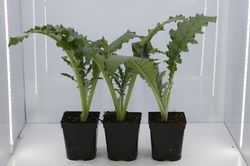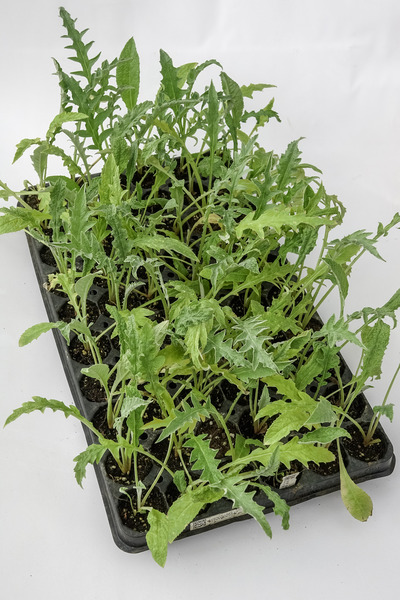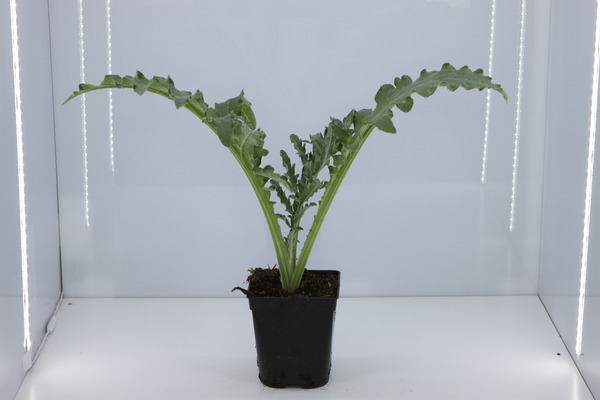 Along with the introduction of the vegetable young plant group 'EverVeg®', we have also expanded our assortment of artichoke young plants. Besides the well-known green artichokes, we are happy to now be able to offer you artichoke young plants of varieties that form reddish flower heads. With our new artichoke young plants assortment, we are making our contribution to distribute this delicious Mediterranean vegetable further in Central Europe and at the same time delighting gourmets all over the world.
Along with the introduction of the vegetable young plant group 'EverVeg®', we have also expanded our assortment of artichoke young plants. Besides the well-known green artichokes, we are happy to now be able to offer you artichoke young plants of varieties that form reddish flower heads. With our new artichoke young plants assortment, we are making our contribution to distribute this delicious Mediterranean vegetable further in Central Europe and at the same time delighting gourmets all over the world.
Artichoke variety trial in Switzerland
The expansion of our range of artichoke young plants is largely based on the results of a variety trial at our partner company Lubera® in Switzerland. Here, a wide range of diverse artichoke and cardoon (artichoke thistle) varieties were tested at two locations.
One site was located directly on the Lubera® premises; another site was located at an agricultural school a few kilometres down the Rhine River. At both sites, an identical assortment of 22 artichokes and 6 cardoon varieties was planted and regularly evaluated. In addition to regular F1 cultivars, which are also used in commercial cultivation, open-pollinated artichoke cultivars, some of which were also local and/or historical, were also planted in this variety trial.
The background of this variety trial was to find out which varieties already form flower buds and thus would provide a first yield in the planting year. The planting took place in mid-May with strong plants from 13 cm pots. The assessment was carried out on the one hand by employees of the agricultural school and on the other hand by the Lubera® breeding team. The results obtained from the variety trial are now reflected in the artichoke young plants range at Lubera Edibles.
However, testing for earliness is only the first step. It is already known from other previous trials (variety trial at the vegetable trial farm of the State Institute for Viticulture and Horticulture in Bamberg, Germany) that artichokes can indeed already produce a yield in the first year. However, yields from the second year onwards can also be significantly higher, provided that the plants have overwintered well.
Artichoke young plants – the EverVeg® assortment gets a new addition
Because we at Lubera Edibles were directly involved in the evaluation of the artichoke variety trial described above and therefore had direct access to the data obtained, we were able to implement the results in an expanded artichoke young plant assortment in a very short time.
Artichoke young plant 'Tavor' – the strong-growing classic

Picture: Artichoken young plants of the variety 'Tavor'
The artichoke variety 'Tavor' belongs to the variety group of 'Green Globe' types. Similar to all of the varieties belonging to this group,'Tavor' has large, green and spherical to flat-round flower buds. The plants are quite vigorous with long, silvery-grey and nearly thornless leaves in a basal leaf rosette. They can grow more than 70 cm tall without inflorescence, reaching a diameter of up to 100 cm. The inflorescence, which reliably forms in the first year, can reach a height of more than 150 cm. If the flower buds are not harvested, large, bright violet-blue flowers form starting in July, which become a real magnet for insects. Despite the relative hardiness of this variety, adequate winter protection with straw, leaves or brushwood should not be omitted.
Artichoke young plant 'Vert de Laon' (Grüne von Laon)
The artichoke variety 'Vert de Laon' is an open-pollinated, historical artichoke cultivar from France. The cultivar name goes back to the commune of Laon in north-eastern France (143 km northeast of Paris; 55 km northwest of Reims). The commune was already a major cultivation area for artichokes in the early 19th century. Since 1886, the variety 'Vert de Laon' has been officially listed in vegetable catalogues.

Picture: well developed Artichoken plant 'Vert de Laon' in C1.3
'Vert de Laon' is characterised by its high yields and fairly good frost hardiness. The large, green flower buds have a broad, round shape. The plants of this old artichoke variety are vigorous with green foliage that is silvery frosted on the underside. Without inflorescence, the plants can reach a height of more than 70 cm and easily cover an area of 1 m². The inflorescence reaches a height of up to 150 cm during the summer.
Artichoke young plant 'Colorado Red'
As the name of the variety suggests, the open-pollinated artichoke variety 'Colorado Red' is characterised by its red-purple flower buds. Depending on the location and climatic conditions, the red colouration can be sometimes more intense, sometimes less. The colour of the bracts may also vary between red, purple and plum. This variety has been specially selected for its suitability for annual cultivation. This is to ensure that artichokes can be grown and harvested even in latitudes where the overwintering of artichoke plants is almost impossible.
The breeding of these red artichoke varieties can be traced back to the breeding work of Keith Mayberry, who worked at the University of California in Davis (California/USA) and from whose work the well-known F1 artichoke hybrid 'Imperial Star' also emerged. The artichoke 'Colorado Red' is based on a cross between 'Imperial Star' with artichoke populations originating from the Peruvian Andes.
Although the 'Colorado Red' artichoke was specifically selected for annual cultivation, with sufficient winter protection or in warmer areas (e.g. wine-growing climates), this variety also produces good yields over several years.
Order now!
Are you now interested in artichokes? Then ask us about the current availability of our artichoke young plants or order your desired quantity now for the coming season. The earlier you order, the more certain it is that we can deliver your desired variety.
More artichoke articles!
If we have now sparked your interest in our artichoke young plants, then check out our other blog article on the subject of artichokes, in which we present more information about this interesting plant.
Artichoke young plants – more than just edible thistles
You can find more blog articles on the topics of 'Vegetable Young Plants' and 'EverVeg® Plants' here:
